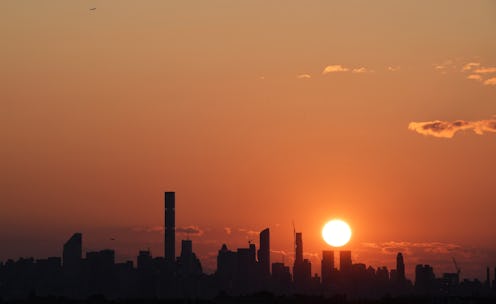
One of summer's most beloved features, especially for those of us who work long hours, is its extended daylight. The sun is early to rise and late to bed, just like us. But once the chilly bite of fall comes back into the air, we brace ourselves for the inevitable day when we've seen the sun for all of two minutes before it sets. So when does it start getting dark earlier in 2017? The answer is a bit more complicated than you'd think.
Because our seasons are cyclical and we're captives on a carousel of time, daylight hours are constantly evolving. But the autumnal equinox, when the daytime and nighttime are essentially split evenly, 12 hours each, signals the point when, within a 24-hour window, it's dark for longer than it is light. That equinox, which for centuries has been celebrated as a festival of harvest and abundance as well as reflection on the past year, is coming up on Friday, Sept. 22.
Each year contains two equinoxes (spring and autumnal) and two solstices ( summer and winter), which exist as polar opposites. The summer solstice, in June, is the longest day of the year. The winter solstice, in December, is the shortest. The spring equinox in March marks the day when the days become officially longer than the nights; the autumnal equinox marks the opposite when it rolls around in late September. But to be clear, the days have subtly been shortening since the summer solstice. Friday just marks the shift of the day-to-night ratio.
Yes, Chelsea Handler, Mother Nature is very tricky.
Predictably, the autumnal equinox has held a special place in cultures for centuries. In Ancient Greece, the shortening of days marked Persephone's descent with Hades into the underworld, where she remained for six months of the year. Her mother, Demeter, the goddess of harvest and agriculture, would abandon her post in grief and in search of her daughter, hence the desolation of winter. Greeks celebrated the harvest and the year's final days of agricultural abundance, while reflecting on the failures and successes of the past year. The equinox was also believed to be the ideal time of the year to engage in protection and safety rituals.
China still celebrates the Mid-Autumn Festival, which falls within the first two weeks of October (no, it's not specifically on the autumnal equinox, but the vibe is very much in line), believed to be the point in the year when the moon is the fullest. Since 2008, it's been a public, three-day holiday in China, although the tradition dates back thousands of years. Families gather for a large meal, hang lanterns and eat moon cakes, traditionally salty egg yokes encased in paste made from lotus seeds or beans. This year, the festival, which is considered second only to the Chinese New Year in grandiosity, falls on Oct. 4.
For pagans, the autumnal equinox marks the arrival of Mabon, one of eight annual Sabats, or Witches' Sabbaths, that are spaced evenly throughout the year's seasons. Mabon focuses on the equal balance of day and night marked by the equinox. They give thanks to the waning light and pay their respects to the impending darkness. Wiccans celebrate the Goddess as she transitions from Mother to Crone, the final of the three Goddess forms. The day typically includes a large family meal and dressing in your fanciest, witchiest duds.
Druids honor The Green Man (no Always Sunny jokes, please), whom they believe rules the forest, during what they call Mea'n Fo'mhair. Druids give offerings to trees, including food, wine, cider, herbs and fertilizer — hey man, trees gotta feast, too.